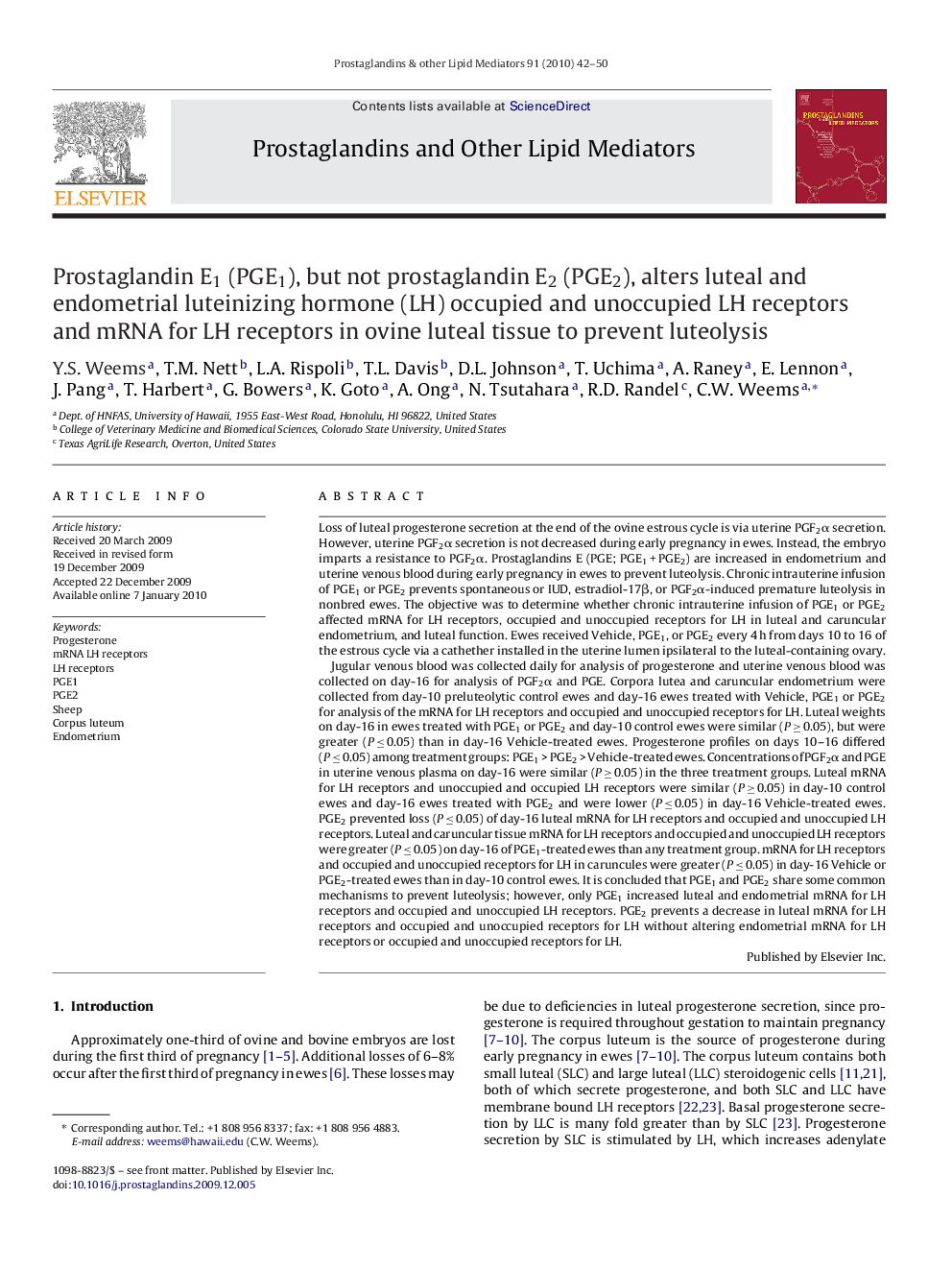| کد مقاله | کد نشریه | سال انتشار | مقاله انگلیسی | نسخه تمام متن |
|---|---|---|---|---|
| 2019821 | 1542237 | 2010 | 9 صفحه PDF | دانلود رایگان |

Loss of luteal progesterone secretion at the end of the ovine estrous cycle is via uterine PGF2α secretion. However, uterine PGF2α secretion is not decreased during early pregnancy in ewes. Instead, the embryo imparts a resistance to PGF2α. Prostaglandins E (PGE; PGE1 + PGE2) are increased in endometrium and uterine venous blood during early pregnancy in ewes to prevent luteolysis. Chronic intrauterine infusion of PGE1 or PGE2 prevents spontaneous or IUD, estradiol-17β, or PGF2α-induced premature luteolysis in nonbred ewes. The objective was to determine whether chronic intrauterine infusion of PGE1 or PGE2 affected mRNA for LH receptors, occupied and unoccupied receptors for LH in luteal and caruncular endometrium, and luteal function. Ewes received Vehicle, PGE1, or PGE2 every 4 h from days 10 to 16 of the estrous cycle via a cathether installed in the uterine lumen ipsilateral to the luteal-containing ovary.Jugular venous blood was collected daily for analysis of progesterone and uterine venous blood was collected on day-16 for analysis of PGF2α and PGE. Corpora lutea and caruncular endometrium were collected from day-10 preluteolytic control ewes and day-16 ewes treated with Vehicle, PGE1 or PGE2 for analysis of the mRNA for LH receptors and occupied and unoccupied receptors for LH. Luteal weights on day-16 in ewes treated with PGE1 or PGE2 and day-10 control ewes were similar (P ≥ 0.05), but were greater (P ≤ 0.05) than in day-16 Vehicle-treated ewes. Progesterone profiles on days 10–16 differed (P ≤ 0.05) among treatment groups: PGE1 > PGE2 > Vehicle-treated ewes. Concentrations of PGF2α and PGE in uterine venous plasma on day-16 were similar (P ≥ 0.05) in the three treatment groups. Luteal mRNA for LH receptors and unoccupied and occupied LH receptors were similar (P ≥ 0.05) in day-10 control ewes and day-16 ewes treated with PGE2 and were lower (P ≤ 0.05) in day-16 Vehicle-treated ewes. PGE2 prevented loss (P ≤ 0.05) of day-16 luteal mRNA for LH receptors and occupied and unoccupied LH receptors. Luteal and caruncular tissue mRNA for LH receptors and occupied and unoccupied LH receptors were greater (P ≤ 0.05) on day-16 of PGE1-treated ewes than any treatment group. mRNA for LH receptors and occupied and unoccupied receptors for LH in caruncules were greater (P ≤ 0.05) in day-16 Vehicle or PGE2-treated ewes than in day-10 control ewes. It is concluded that PGE1 and PGE2 share some common mechanisms to prevent luteolysis; however, only PGE1 increased luteal and endometrial mRNA for LH receptors and occupied and unoccupied LH receptors. PGE2 prevents a decrease in luteal mRNA for LH receptors and occupied and unoccupied receptors for LH without altering endometrial mRNA for LH receptors or occupied and unoccupied receptors for LH.
Journal: Prostaglandins & Other Lipid Mediators - Volume 91, Issues 1–2, February 2010, Pages 42–50